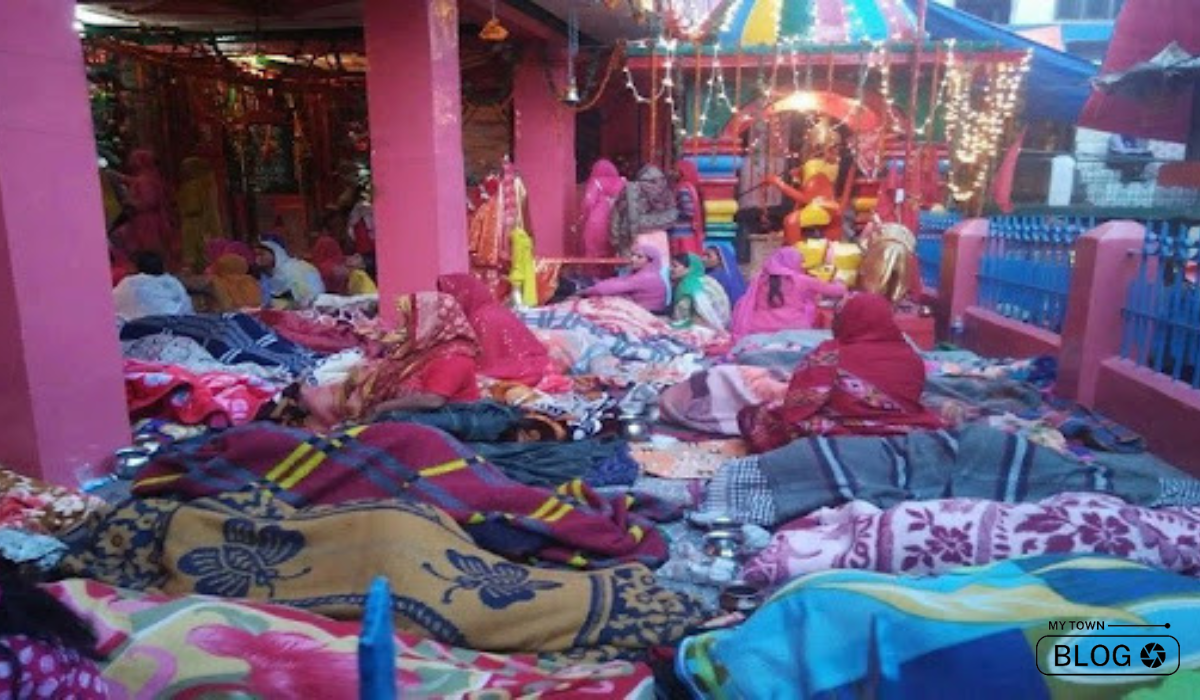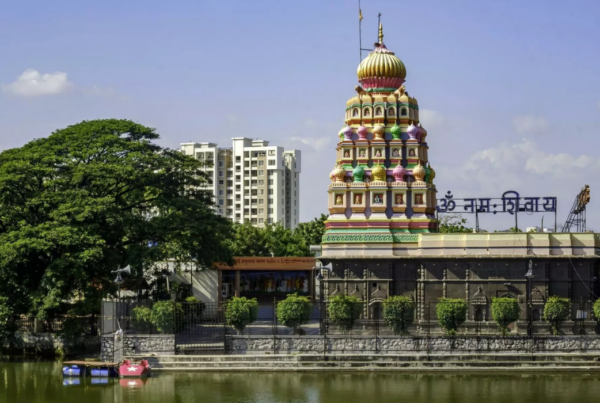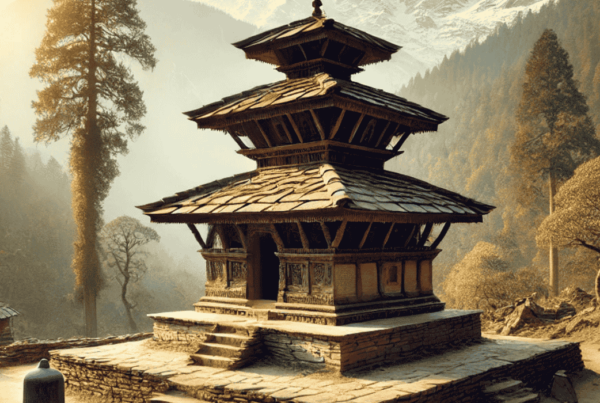Simsa Mata Mandir is a Hindu temple located on the top of beautiful hills, 3000+ ft above sea level in the Mandi district of Himachal Pradesh, India. The temple is dedicated to the Sharada Devi. It is located in the Simsa village, 30 km from the Baijnath Nagar and 17 km from Palampur. Simsa temple is one of the famous temples of Himachal Pradesh. This temple of Simsa Devi is unique. A childless woman in this temple sleeps on the floor of the Simsa Mata Mandir, and the woman gets children.
It is also known as Santan Datri Temple. Here Mother Sharda sits in the form of Pindi. Temples of Simsa Devi are famous in North India, especially in Himachal Pradesh, Punjab, Haryana, and Delhi.
The villagers around the temple consider it to be 400 years old, though the age and antiquity of this temple remain unknown.
According to ancient belief, the women who sleep in the temple day and night sleep on the floor of the temple and Simsa Mata comes in her dream and gives blessings to get children.
According to belief, Simsa Mata herself indicates the gender of the child in the dream. If a childless woman gets the fruit of guava in her dream, she will have a boy and if she gets a lady’s finger, it will be a girl. Apart from this, if the woman finds any metal, wood, or object in her dream, it means that she will not have any child.
The Simsa Mata temple organizes special programs during Navratri. During this time, the locals celebrate the Salindra or Selindra festival here. Selindra means coming in a dream. During this time, childless women from neighboring states of Himachal Pradesh come to this temple to seek a mother’s darshan with the desire for children, making this festival particularly special. The grace of Mother bestows happiness upon the children who sleep in the temple premises.
The mystery of dreams:
When the goddess was installed in the form of a deity, King “Jaugindra Sain” of Mandi village came to Simsa village with his religious wife to catch a glimpse of the goddess. They had no children, and they were coming on the footpath from Lad-Bhadol village to Simsa village. They had covered only half the distance when they decided to rest under a large tree. The queen fell asleep, and Sharda Mata appeared in the form of a maiden in her dream, giving her a fruit and saying that she was Sharda Mata, whose installation took place in Simsa village recently. She advised them not to eat the fruit and not to let the king eat it either.
It is said that a year later, the king’s household had the birth of a son. Then the mystery of the mother’s dream slowly unfolded. People began to experience dreams of having children, and the mother’s name became synonymous with the bestower of offspring, Sharda Mata. In today’s era, people come to the goddess’s temple from both within the country and abroad to seek dream interpretations for the attainment of children. And the Mother Goddess is fulfilling their desires.
The Blessings of Mother Sharda:
The blessings of Mother Sharda always remain upon all devotees. The uniqueness of the Mother is acknowledged for the attainment of progeny. However, the Mother Goddess fulfills all kinds of desires. A man named Kimu lived in the village of Sanda-Patan, which is located 5 km away from Simsa village. He belonged to a very poor family and got married at a young age. His wedding took place in the village of Drob, which is 10 km from Simsa village and 15 km from Sanda-Patan village. Due to extreme poverty, he often lacked food and clothing. Therefore, his wife chose to live with her parents.
One day, when he went to bring his wife, he did not send her back with him. He stated that he would only send his daughter with Kimu when he comes back riding on a trim (a type of horse). As it was getting late, Kimu stayed overnight in a cowshed. During the night, a cow ate his clothes, and in darkness, he had to travel back to Sanda village without proper attire. On his way, he climbed a hill and hid behind a rock due to being clothing-less. Mother Sharda, who knew everything, called out to Kimu. He was astonished that this woman knew his name. However, it was not a woman but Mother herself.
After Performing Ablutions:
She returned to the temple. Mother said, “I know everything. A soldier from the kingdom of Mandi will come to you. Go with him to Mandi and do as I instruct you.” Eight days later, exactly as Mother predicted, a soldier from Mandi arrived. He was amazed when Kimu, despite being uneducated, correctly answered all the king’s questions. Pleased, the king granted him wealth and a horse for transportation. Kimu was overjoyed, and riding the horse, he returned to his in-laws’ village, Lad-Bhadol, located near Simsa. He went there and declared, “I have brought my wife riding on a horse.” The bride’s family was surprised to see Kimu, now a prosperous man. All these events were miracles of Mother Sharda. He gradually began to use Mother’s powers for his benefit. Once, he advised the king to cast a net into the river, promising that trapped birds and fishes would be found. Later, he suggested placing nets in the forest, assuring the capture of fish.
Eventually, Mother revealed in a dream that due to Kimu’s misuse of her powers, misfortunes were occurring. She instructed him to stop, but Kimu couldn’t resist using her powers. One day, he dreamed that his daughter’s wedding procession was heading towards Simsa village. Mother Sharda appeared and said that as he had misused her powers, this was happening. When he woke up, he couldn’t answer the king’s questions. Realizing his mistake, he confessed to the king and explained everything. The king was pleased with his honesty which made him wealthy. Kimu, now remorseful, prayed to Mother Sharda for forgiveness. From then on, Kimu was known as a lawyer in the village of Sanda-Patan.
The history of the Simsa village:
Approximately 400 years ago, there were around 6-7 houses in Simsa village. When the king’s son successfully completed his vow or wish (mannat), the king brought the Sharda Mata temple to Simsa. The king then inquired from the villagers about the presence of any Pandit or priest. The locals mentioned that there were no Brahmin priests in the village. Subsequently, the king instructed his minister to bring a Brahmin priest from the Bhata community in Jammu to perform the worship and rituals of the goddess. After that, an 11-12-year-old Brahmin boy from the Bhata community in Jammu was brought. Due to his young age, he had to return home after a short period, and the process had to be repeated. Eventually, the villagers decided to arrange his marriage in the nearby village called Jhulgana, primarily inhabited by Brahmins. This way, he stayed with his family and did not have to go back to Jammu.
He married and fathered two sons named Kaliya and Baliya, marking the beginning of the growth of the priestly lineage. Today, in the modern era, there are approximately 40 to 50 priest households in the village.
The glory of the Mother’s sacred pond:
A pond (pit) covered with a stone is adjacent to the Mother’s shrine. Inside it, there are small sculptures in the form of children, feet, Mother’s form, and Shiva’s form. Various statues depict children of different shapes, with features like noses, ears, mouths, etc. (considered as the children of Sharda Mata). The priests remove these sculptures from the pit twice a year, a few days before the Navaratri festival. Navaratri occurs twice a year, first in the month of Chaitra and second in the month of Ashwin.
They take out the sculptures during these months.
Sometimes, the number of sculptures is less, and sometimes it is more. Believers hold the belief that the Mother Goddess distributes these children to women who come here to seek blessings through dreams.
When devotees witness the children being taken out with their own eyes, they feel blessed. After cleaning the pond and bathing the sculptures, they place them back in the same pit.
Procedure for performing worship:
All the priests, according to their turn, bring water from the holy pond using the Mother’s vessel (vavli) for her bath during both morning and evening prayers. They light incense, offer lamps, and create the sound of conch shells along with singing hymns for Mother.
Note:
All priests share the responsibility equally in worshiping and performing rituals for the Mother. There is no chief priest. Couples without children visit the Sharda Mata temple in Simsa for the blessing of progeny.
Hoping to be blessed with children, women perform special rituals to seek conception. Before taking a dream, women should eat something if hungry, as the process involves fasting until they take the dream, and they should consume only water. Afterward, they perform an ardas (prayer) to the Mother and take a dream in the form of a clay model representing the Mother’s sanctum.
After the dream, they have a glimpse of the Mother in the form of the Mother’s pindi (idol) and receive fruits as a reward in the Mother’s courtyard. The current practice involves women bathing after taking a dream and then performing an ardas to the Mother. The Mother, in the form of a dream, may provide various fruits, vegetables, children, and flowers. The woman, upon realizing her dream, offers various items to the Mother as gratitude. The Mother may appear in various forms, such as the Mother’s form, a maiden’s form, or in the form of a woman related to the dreamer, like a mother-in-law, sister, sister-in-law, or any other form.
Rituals:
The woman places any fruit representing her dream on her lap. When the woman senses that she has taken a dream and received the fruit, she later offers offerings such as vermillion, a scarf, and sweets to the Mother, then happily returns home. The couple takes care of the fruit received in the dream, neither eating it nor giving it to others. When a child is born to them after one or two years, they joyously come to the Mother’s temple to dance and sing in gratitude.
Be aware that the Mother should offer the fruit given in the dream. For example, if the dream gives an apple, offer an apple; if it gives a mango, offer a mango; if it gives a banana, offer a banana; if it gives a pomegranate, offer a pomegranate; if it gives a flower, offer a flower; if it gives a child, and it’s a boy, offer a male goat, and if it’s a girl, offer a female goat. Note: There is no fixed time for dreams; it can happen within an hour, two hours, a day, two days, five days, or even ten days.
Note: Dreams do not have a fixed duration, and they can occur within one hour, two hours, a day, two days, five days, or even ten days.
Items To Bring Along:
When accommodating the person accompanying her in a free guesthouse, she should bring her petticoat, skirt, water vessel, and blanket for sleeping. Apart from that, during the rest of the year, when women come to achieve their dreams (Swapan), the person accompanying them is provided with free accommodation and meals (food) by the priest himself.
Temple Committee’s Work:
The priests themselves form the temple committee for the pujaris at regular intervals. The committee manages all the arrangements with the assistance of the priests, such as expanding the temple, constructing accommodations, building toilets, etc. In the year 2019-2020, the committee and devotees supported the undertaking of silver work worth 2.50 crore rupees in the sanctum sanctorum of Mata. Currently, there are 15-20 rooms in the accommodation, 10 toilets, 2 bathing areas, and a large dining hall in the temple complex.
The temple committee, in collaboration with the priests and the support of the devotees, carries out all these activities. The distance from Delhi to Chandigarh and Chandigarh to Baijnath, Baijnath to Simsa Mata, is only 30 km. From Baijnath, the nearest railway station is Mahakal, then Choubin Lada-Bhadol, from Lada-Bhadol to Gagal, and from Gagal to the temple, which is only 5 km away. Devotees coming from Vilaspur, Shraddhalu Vilaspur, will arrive through Sarkaghat to Dharampur Neri Tulah Gagal, and the temple is 5 km away. Parking facilities are available. For further information, please contact the addresses provided below.
How to Visit Simsa Mata Temple:
Nearest Railway Station :
Pathankot Junction at a distance of nearly 157 kilometers from Simsa Mata Mandir.
Nearest Airport :
Kangra Airport at a distance of nearly 82.5 kilometres from Simsa Mata Mandir.
Time to go to the temple to get children :
During the Navratri Festival.
Timings: Open 24 Hours.
Address:
Opposite Mata Mandir Ladbharol, Simsa Mata Mandir Rd, Simas, Himachal Pradesh 175016.
Also Read: Baijnath Temple Himachal: Origins, History, And Location
Simsa Mata Temple: (FAQs)
Where is Simsa Mata Temple located, and what is its significance?
Situated on the picturesque hills in the Mandi district of Himachal Pradesh, India, Simsa Mata Temple stands 3000+ ft above sea level. Dedicated to Sharada Devi, the temple is located in Simsa village, known for its uniqueness in fulfilling the desires of childless women. People often refer to it as Santan Datri Temple.
How old is Simsa Mata Temple, and what makes it unique?
Local belief suggests that the temple is around 400 years old, although the exact age is not known. What makes it unique is its association with fulfilling the desires of childless women. In their dreams, Simsa Mata blesses women who sleep in the temple, indicating the gender of the child they will have.
What is the significance of dreams at Simsa Mata Mandir?
In their dreams, Simsa Mata provides guidance and blessings to women seeking children by sleeping in the temple. The dreams may include symbols like fruits, indicating the gender of the child. The accuracy of such dream interpretations especially distinguishes the temple.
During Navratri, Simsa Mata Mandir organizes what special programs?
During Navratri, the temple celebrates the Salindra or Selindra festival, where childless women from neighboring states visit in the hope of conceiving. Devotees consider the festival special and come to seek blessings from Simsa Mata.
How does Simsa Mata fulfill the desires of devotees?
Believers think that Simsa Mata blesses devotees with various dreams, indicating the fulfillment of desires. The dreams may include fruits, vegetables, children, and flowers. Devotees offer gratitude by bringing offerings corresponding to the items received in their dreams.
What is the history behind the Simsa village and the temple’s priestly lineage?
Around 6-7 houses marked the beginning of Simsa village, and the king brought the temple to the village after successfully completing his vow. The priestly lineage began with a Brahmin boy from Jammu, and today there are approximately 40 to 50 priest households in the village.
What is the significance of the Mother’s sacred pond at Simsa Mata Mandir?
Adjacent to the temple, there is a pond with small sculptures depicting children, feet, Mother’s form, and Shiva’s form. Believers think that Simsa Mata distributes these sculptures to women seeking blessings through dreams. They clean the pond twice a year during Navratri.
What is the procedure for performing worship and rituals at Simsa Mata Mandir?
The priests, on a rotational basis, bring water from the sacred pond for the Mother’s bath during morning and evening prayers. All priests share the responsibility equally, and there is no chief priest. Devotees, especially couples without children, visit the temple for blessings, and women perform special rituals for conceiving.
What items should a woman bring along when visiting Simsa Mata Mandir?
A woman should bring her petticoat, skirt, water vessel, and blanket for sleeping. The person accompanying her is provided with free accommodation and meals during the visit.
How can one reach Simsa Mata Temple, and are there any special timings?
The nearest railway station is Pathankot Junction (157 km away), and the nearest airport is Kangra Airport (82.5 km away). The temple is open 24 hours. The best time to visit to seek blessings related to children is during the Navratri Festival.
Is Simsa Mata Mandir associated with any historical incident?
Yes, a historical incident involves a man named Kimu, who prayed to Mother Sharda for help in his difficult circumstances. The Mother’s guidance and blessings transformed his life, illustrating the power of faith and devotion.
Can one take dreams at any time, and is there a fixed duration for dreams?
Dreams do not have a fixed duration, and they can occur within one hour, two hours, a day, two days, five days, or even ten days. There is no fixed time for dreams; they can happen anytime.
Please note: The FAQs provide a comprehensive overview of Simsa Mata Mandir, its rituals, significance, and associated beliefs. The temple encourages visitors to respect the traditions and practices observed.








